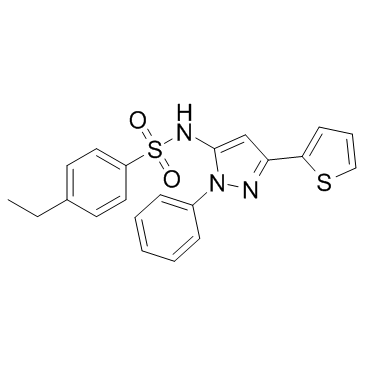| Cas No.: | 1196723-93-9 |
| Chemical Name: | 4-ethyl-n-[1-phenyl-3-(2-thienyl)-1h-pyrazol-5-yl]benzenesulfonam Ide |
| Synonyms: | 4-ethyl-n-[1-phenyl-3-(2-thienyl)-1h-pyrazol-5-yl]benzenesulfonam Ide;HSF1A |
| SMILES: | O=S(C1=CC=C(CC)C=C1)(NC2=CC(C3=CC=CS3)=NN2C4=CC=CC=C4)=O |
| Purity: | >98% |
| Sotrage: | 2 years -20°C Powder, 2 weeks 4°C in DMSO, 6 months -80°C in DMSO |
| Description: | HSF1A is a cell-permeable activator of heat shock transcription factor 1 (HSF1). |
| In Vivo: | HSF1A enhances HSF1 activity, stabilizes HSF1 expression and minimizes Doxorubicin (DOX)-induced cardiac damage. WKY rats are challenged with DOX (accumulated dose: 30 mg/kgw), and DOX combined with HSF1A (100 mg/kgw/day). Supplementation with HSF1A significantly elevates cardiac functions back to the levels of the control group. HSF1A has been shown to stimulate human HSF1 nuclear translocation, elevate protein chaperone expression and ameliorate protein misfolding and cell death in a neurodegenerative disease model. The echocardiographic results show that HSF1A also alleviates DOX-induced failures in cardiac function[3]. |
| In Vitro: | HSF1A protects cells from stress-induced apoptosis, binds TRiC subunits and inhibits TRiC activity without perturbation of ATP hydrolysis. Genetic inactivation or depletion of the TRiC complex results in human HSF1 activation and HSF1A inhibits the direct interaction between purified TRiC and HSF1 in vitro. Moreover, fluorescence anisotropy experiments using FITC coupled to HSF1A demonstrates that HSF1A-FITC binds to a purified Tcp1 subunit of TRiC with an affinity of approximately 600 nM. This is validated qualitatively via titration of purified Tcp1 into binding reactions containing 500 nM Biotin or HSF1A-Biotin[1]. Quantification by counting the number of cell containing aggregates as a function of the total number of cells reveals that at HSF1A concentrations as low as 2 µM, a reduced number of aggregate-containing cells are observed. The fraction of cells containing aggregates continued to decrease in a dose-dependent manner such that pretreatment with 12 µM HSF1A resulta in ~20% of the cells exhibiting aggregates visible by fluorescence microscopy[2]. |
| Kinase Assay: | Protein extracts are generated from mammalian, yeast and E. coli cultures using biotin-binding buffer (20 mM HEPES, 5 mM MgCl2, 1 mM EDTA, 100 mM KCl, 0.03% NP-40) supplemented with 1% Trition-X100 and protease inhibitors. Approximately 0.5 mg of protein extract is incubated with 100 μM HSF1A-Biotin for 4 h at 4°C and HSF1A-Biotin associated proteins captured by with NeutrAvidin Agarose Resin. After washing in biotin binding buffer proteins are eluted using 50 μL biotin elution buffer (100 mM Tris, 150 mM NaCl, 0.1 mM EDTA, 2 mM D-biotin), resolved on a 4-20% SDS-PAGE, and immunoblotted. For purified TRiC and Hsp70 analyses, 5 nM protein is incubated in biotin-binding buffer+0.5% Triton X-100 with 100 μM biotin or 100 μM HSF1A-Biotin for 4 h at 4°C and captured with NeutrAvidin Resin. For NiNTA purified yeast Tcp1, different concentrations of Tcp1 0.5 μM, 1 mM, 2 mM, 3 mM and 4 mM in 25 mM Hepes pH 7.5, 150 mM NaCl are incubated with 0.5 μM Biotin or HSF1A-Biotin for 4 h at 4°C and captured with NeutrAvidin Resin[1]. |
| Cell Assay: | PC12 cells seeded into a 96-well plate (5×104 cells/well) are treated with increasing concentrations of HSF1A (2, 4, 8 and 12 μM) for 15 h, at which time httQ74-GFP expression is stimulated by incubation in the presence of 1 µg/mL Doxycycline for 5 d. Cell viability is assessed via the XTT viability assay[2]. |
| Animal Administration: | Rats[3] Ten-week-old Wistar Kyoto rats (WKY) are used. The rats are housed at a constant temperature (22°C) on a 12-h light/dark cycle with food and tap water. The animals are arranged into three groups: WKY rats (the control group), DOX rats and DOX rats treated with HSF1A. Each group contain five animals. The DOX group is injected with DOX (5 mg/kg) for 6 consecutive weeks intraperitoneal injection to achieve a cumulative dose of 30 mg/kg, which has been well documented to achieve cardiotoxicity. The small molecular HSF1 activator HSF1A (100 mg/kg/day) is injected intraperitoneally. |
| References: | [1]. Neef DW, et al. A direct regulatory interaction between chaperonin TRiC and stress-responsive transcription factor HSF1. Cell Rep. 2014 Nov 6;9(3):955-66. [2]. Neef DW, et al. Modulation of heat shock transcription factor 1 as a therapeutic target for small molecule intervention in neurodegenerative disease. PLoS Biol. 2010 Jan 19;8(1):e1000291. [3]. Huang CY, et al. Doxorubicin attenuates CHIP-guarded HSF1 nuclear translocation and protein stability to trigger IGF-IIR-dependent cardiomyocyte death. Cell Death Dis. 2016 Nov 3;7(11):e2455. |

 DC Chemicals' products qualify for U.S. tariff exemptions. We guarantee no price increases due to customs duties and maintain stable supply, continuing to deliver reliable research solutions to our American clients.
DC Chemicals' products qualify for U.S. tariff exemptions. We guarantee no price increases due to customs duties and maintain stable supply, continuing to deliver reliable research solutions to our American clients.





















